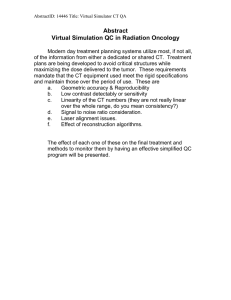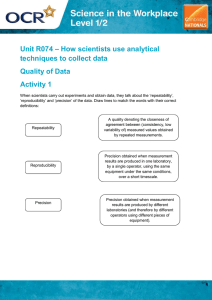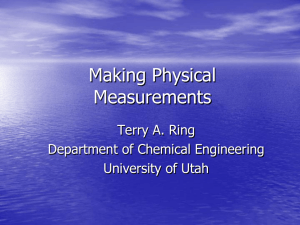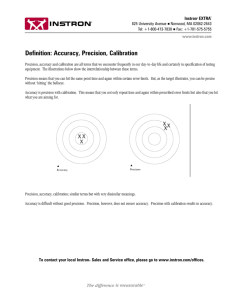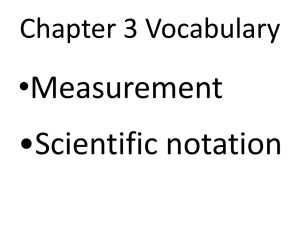Instrumentation
advertisement
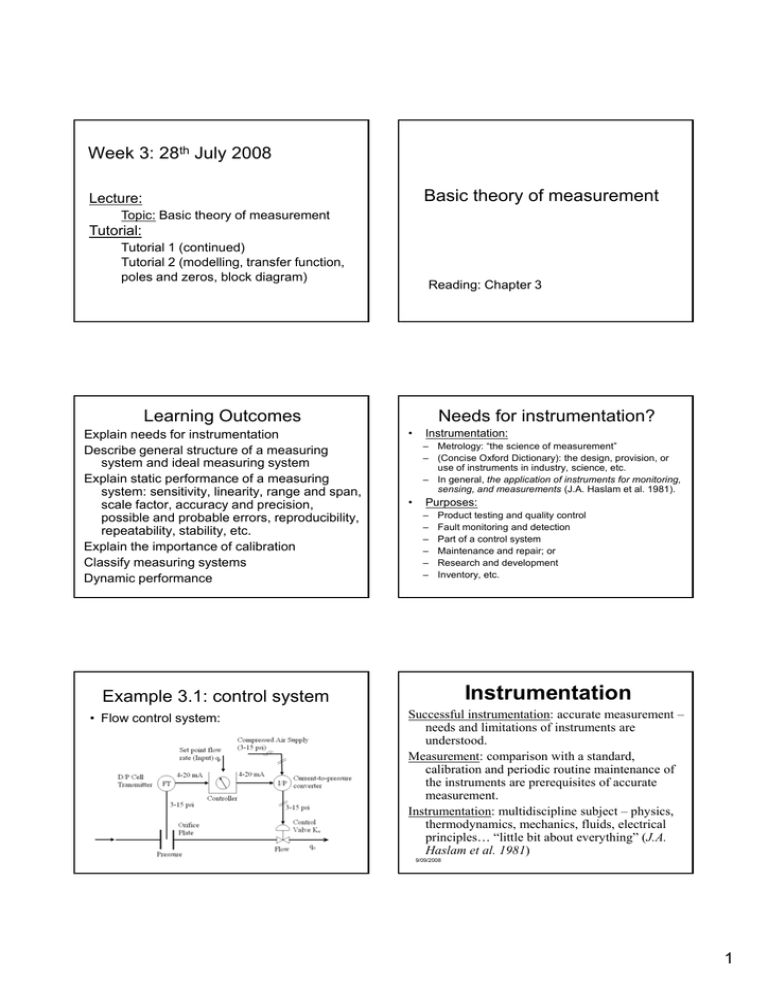
Week 3: 28th July 2008 Basic theory of measurement Lecture: Topic: p Basic theoryy of measurement Tutorial: Tutorial 1 (continued) Tutorial 2 (modelling, transfer function, poles and zeros, block diagram) Reading: Chapter 3 Learning Outcomes Explain needs for instrumentation Describe general structure of a measuring system and ideal measuring system Explain static performance of a measuring system: y sensitivity, y, linearity, y, range g and span, p , scale factor, accuracy and precision, possible and probable errors, reproducibility, repeatability, stability, etc. Explain the importance of calibration Classify measuring systems Dynamic performance Needs for instrumentation? • Instrumentation: – Metrology: “the science of measurement” – (Concise Oxford Dictionary): the design, provision, or use of instruments in industry, science, etc. – In general, the application of instruments for monitoring, sensing, and measurements (J.A. Haslam et al. 1981). • Purposes: – – – – – – Product testing and quality control Fault monitoring and detection Part of a control system Maintenance and repair; or Research and development Inventory, etc. Instrumentation Example 3.1: control system • Flow control system: Successful instrumentation: accurate measurement – needs and limitations of instruments are understood. Measurement: comparison with a standard, calibration and periodic routine maintenance of the instruments are prerequisites of accurate measurement. Instrumentation: multidiscipline subject – physics, thermodynamics, mechanics, fluids, electrical principles… “little bit about everything” (J.A. Haslam et al. 1981) 9/09/2008 1 General Structure of Measuring System Transduced signal Primary qquantityy Transducer Physical variable Measurand Sensor Converter Transmitter Measuring system Conditioned signal Signal Conditioner Recorder or Indicator Converter Amplifier Display Pen recorder Printer, etc. 9/09/2008 Simple measuring system Complicated measuring system with amplifier, A/D converter, and computer output System Performance • Ideal measuring system: where the output signal has a linear relationship with the measurand (quantity to be measured), where no errors are introduced by effects such as static friction, and where the output is a faithful reproduction of the input no matter how the input p varies. • Static Performance: when steady or constant input signals are applied, comparison of the steady output with the ideal case gives the static performance of the system. • Dynamic Performance: when changing input signals are applied, comparison with the ideal case gives the dynamic performance of the measuring system. Static Sensitivity • Static sensitivity is the ratio of the change in output to the corresponding change in input under static or steady state conditions. K= Δy Δu Δy Δu the change in output the change in input Unit depends on the instrument or measuring system being considered. Static Performance • • • • • • Sensitivity Range, Span Accuracy and Precision Linearity Possible and Probable Errors Other Static Performance Terms: Reproducibility, Repeatability, Stability, Constancy, Tolerance, Resolution, Dead-band, Hysteresis. Sensitivity: Example 3.2 A measuring system: a transducer, an amplifier, and a recorder: K1 = 0.2 mV/oC Transducer (oC-mV): Amplifier (mV-V): K2 = 2.0 V/mV Recorder (V-mm): K3 = 5.0 mm/V K = K1 × K 2 × K 3 K = 0.2( mV / o C) × 2.0( V / mV ) × 5.0(mm / V ) K = 2.0mm / O C 2 Example A temperature-measuring system incorporates a platinum resistance thermometer, a Wheatstone bridge, a voltage amplifier, and a pen recorder. The individual sensitivities are transducer: 0.35 ohm/oC, Wheatstone bridge: 0.01 V/ohm, amplifier gain: 100 V/V, and pen recorder: 0.1 cm/V Determine: 1. the overall system sensitivity 2. temperature change corresponding to a recorder pen movement of 4 cm Linearity The ratio of the maximum deviation from a linear relationship (ideal) between the input and output to the maximum scale – expressed as percentage of full scale. Vmax Indicated (V) ΔV ΔV Linearity(%) = ×100% Vmax Actual (V) Example 3.3: Linearity An ohmmeter used to measure resistance in range of 0 to 200 Ohms gave the maximum deviation of 2.0 Ohms. The linearity is as follows Linearity(%) = 2.0V ×100% = 1.0(%) (200 − 0)Ω Range, Span Range of a variable is a numerical statement of the minimum and maximum values that the variable can assume. A DC voltmeter: 0V-30V, mA-meter: 4mA-20mA p is the numerical difference between two Span range values. DC voltmeter: 30V-0V = 30V, mA-meter: 20mA-4mA = 16mA Scale Factor is a number which scales or multiplies the physical quantity to be measured: SF=Sy/Sx or Sy=SF*Sx More example • Data from a dc tachometer test: • Determine the linearity in the full scale? – Least squares to find ideal relationship – Calculate the maximum deviation – Calculate the linearity. Accuracy and Precision • Accuracy is normally stated in terms of errors introduced, where indicated value − true value × 100% true value The error as a percentage of the measuring range of the equipment: error (%) = error (%) = indicated value − true value × 100% max scale value 3 Accuracy and Precision • Precision does not mean accuracy. An instrument provides reading which are very close in value it is said to have high precision. • Ap precise measurement may y not be an accurate measurement. • When repeating measurements of the same input for several times the indicated readings lie closely together, the instrument is said to be of high precision. The accuracy means the closeness of the indicated readings to the true values. Examples of Error A 0-10bar pressure gauge: error of +/0.15bars when calibrated by manufacturer. (a) Percentage error of the gauge: 0.15bars × 100% = ±1.5% 10bars (b) Possible error when reading of 2.0bars: E Error (%) = Error (%) at 2.0bars = 0.15bars × 100% = 7.5% 2.0bars Sources of Error Incorrect observation, incorrect position or graduation of scale… significant sources of error which combine to affect adversely the accuracy of measurements: z Friction, backlash, & inertia (mechanic) z Hydraulic friction, leakage, & inertia (hydraulic) z Heat loss through imperfect insulation and imperfect thermal conductivity z Distributed pneumatic capacitance & resistance z Offset, drift, effects of distributed resistance, conductance, & capacitance, etc. Illustration of difference between accuracy and precision True value H.A. H.P. L.A. H.P. L.A. L.P. Example A 0-100oC thermometer is found to have a constant error of +0.2oC. Calculate the percentage error at readings of (a) 10oC, (b) 50oC and (c) 100oC Possible and Probable Errors Maximum possible error: Maximum possible error = ± (a + b + c)% Probable error: Root-sum-square error = ± a 2 + b 2 + c 2 (%) Example: ± 2% ± 3% ± 5% Effect of disturbance and noise in Ch 16 4 Other static-performance terms • Reproducibility: A general term applied to the ability of a measuring system or instrument to display the same reading for a given input applied on a number of occasion. • Repeatability: The reproducibility when a constant input is applied repeatedly at short intervals of time under fixed conditions of use. • Stability: The reproducibility when a constant input is applied over long periods of time compared with the time of taking a reading, under fixed conditions of use. Standards and Calibration Standards: z Requirement for more accurate measurements has evolved as human beings have developed more complex and sophisticated technologies. z Standards help to make devices manufactured in different places compatible to each other. z It is important to understand the need for calibration and adjustment dj t t off test t t and d production d ti equipment. i t z Australian Standards Organization in Sydney, NSW. Calibration: z Calibration is the process of adjusting test and production equipment to conform to standards, and verifying (certifying) their compliance to those standards. z Calibration methods and period are often instructed by manufacturer of the equipment. Dynamic Performance • The dynamic performance of both measuring and control systems is extremely important and is specified by responses to certain standard test inputs. • Step input: which takes the form of an abrupt change from one steady value to another. This indicates how well the system can scope with the change and results in the transient response. response • Ramp input: which varies linearly with time and gives the ramp response, indicating the steady-state error in following the input. • Sine-wave input: which gives the frequency response or harmonic response of the system. This shows how the system can respond to inputs of a cyclic nature as the frequency f (Hz) or ω (rad/s, ω=2πf) varies. Other static-performance terms • Tolerance: The maximum error. • Resolution: The smallest change of input to an instrument which can be detected with certainty, expressed as a percentage of full scale. • Dead-band: The largest change of input to which the system does not respond due to friction or backlash effects, expressed as a percentage of full scale. • Hysteresis: The maximum difference between readings for the same input when approached from opposite directions, I.e. when increasing and decreasing the input, expressed as a percentage of full scale. • Constancy: The reproducibility when a constant input is presented continuously and the conditions of test are allowed to vary within specified limits, due to some external effect such as a temperature variation. Classification of MSs Types of signal: analogue, digital and hybrid (combination of analogue and digital) Types of physical processes: mechanical, hydraulic, pneumatic, electrical and electronic (microprocessor/computer based) Trend shows an increase of electronic and computer-based measuring equipment because of rapid speed of response, ease with electrical signals, digital and graphical visualization, and reliability and programmability Dynamic Performance • All systems will to some extent fail to follow exactly a changing input; and a measure of how well a system will respond is indicated by its dynamic specifications (step or transient parameters or frequency-response frequency response parameters) • Many systems, although different in nature, produce identical forms of response – the system dynamics are similar 5 Test Input Signals It is necessary for the designer to test the performance of a measuring or control system using test input signals. Test Inputs: Typical test inputs: step, ramp and sine wave Step Ramp Zero-Order System • Zero-order measuring system y = Ku • Step input – step response • Ramp input – ramp response • Sine wave input – frequency response Sine wave 9/09/2008 Examples of zero-order measuring systems • Potentiometer (output voltage proportional to the displacement of the wiper) • The zero-order zero order measuring system has an important property: that the output is proportional to the input no matter how the input varies – ideal measuring system. First-order Systems • First-order measuring system (standard form) τ τ dy + y = Ku dt H= K τs + 1 time constant K: static sensitivity • Step input, ramp input and sine wave input Examples of first-order measuring systems • Mercury-in-glass thermometer, build-up pressure in a resistor/bellows of air p system, a series resistance-capacitance network, etc. Example • Mercury-in-glass thermometer, where the heat conduction through the glass bulb to the mercury is described by a first-order differential equation: dy + 2 y = 2 × 10 −3 u dt dy T = 2sec 2 + y = 10 −3 u K = 10-3m/oC dt 4 6 Example Second-order System Determine the time constant and the static sensitivity of the systems dy a) 30 + 3y = 1.5 ×10 −5 u • Second order measuring system d2 y dy + 2ξωn + ω2n y = ku dt 2 dt y(s) K = u (s) (1 / ω2n )s 2 + (2ξ / ωn )s + 1 dt for a thermocouple in a protective sheath sheath, where y = output voltage in V and u = input temperature in oC. dy b) 1.4 dt + 4.2 y = 9.6u for a resistor/bellows system, y = bellows displacement in mm, and u = input pressure in bars ξ is a measure of the damping present in a system and is equal to the ratio of actual damping to critical damping a measure of the speed of response of the secondωn isorder system – higher values of ω would mean that the n system would response more rapidly to sudden changes Second-order System Example of 2nd-order system • The dynamic performance of a piezo-electric accelerometer can described by the following differential equation: d2y dy + 3.0 × 103 + 2.25 ×1010 y = 11.0 × 1010 u 2 dt dt where y = output charge in pC, and u = input acceleration m/s2. By comparison with the standard equation, determine the values of ωn, ξ and the static sensitivity K. (ans: 1.5*105, 0.01, 4.89pC/(m/s2)) Examples of second-order measuring/control system ξ < 1: The system is said to be underdamped and results in oscillations occurring in the step response and (for values of ξ < 0.707) resonance effects in the frequency response. ξ = 1: This is the critically damped condition: ie no oscillations or overshoots appear in the step response and there is no resonance in the frequency response. This is the point of change-over from an underdamped condition to an overdamped condition. ξ > 1: The system is overdamped in the step response and no resonance in the frequency response. Example: Step-response Specs 140 120 • Mass-spring system with damping, yaw angle vs rudder system (Nomoto). A l large number b off d devices i and d mechanisms. • Simulation in MATLAB/Simulink (illustrates responses with different values of ξ and ωn) 100 80 d2y dy + 2 × 1 × 0 .4 + y = u 2 dt dt 60 40 20 0 0 1 2 3 4 5 6 7 8 9 10 Effect of disturbance and noise in Ch 16 7 Summary • Definition and concepts of instrumentation, needs for instrumentation, ideal measuring system, structure of a measuring system • Static performance of a measuring system: sensitivity, range, span, scale factor, accuracy and precision, i i lilinearity, it possible ibl and d probable b bl errors, reproducibility, repeatability, stability, constancy, tolerance, resolution, dead-band, hysteresis. • Standards & calibration • Classification of measuring systems • Dynamic Performance: test input signals Any questions? Tutorials • Solving differential equations using Laplace transform • Modelling: derive differential equations • Transfer T f function f ti • Poles and zeros • Block diagram 8
